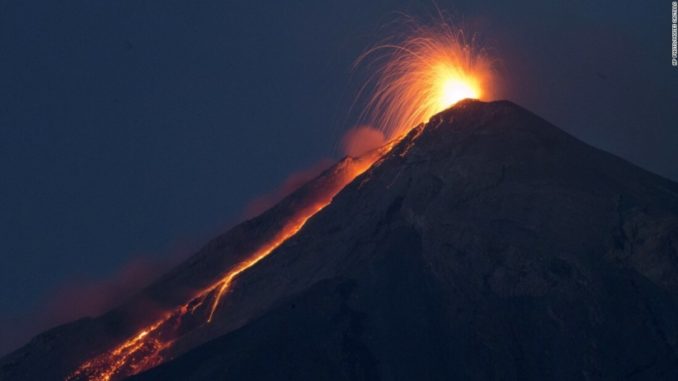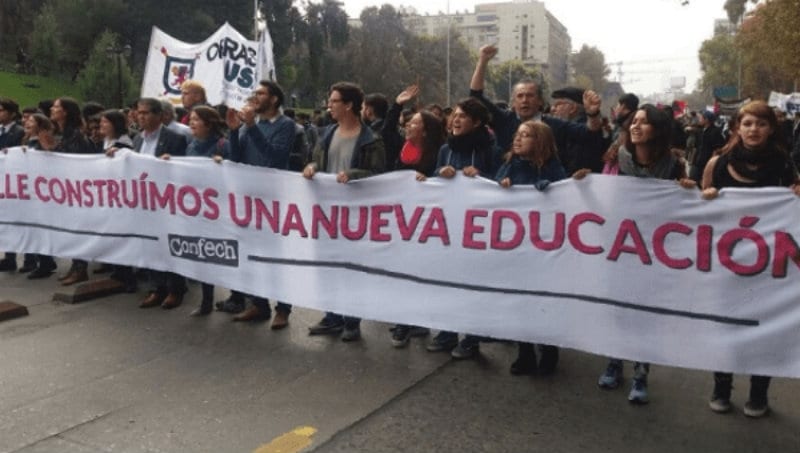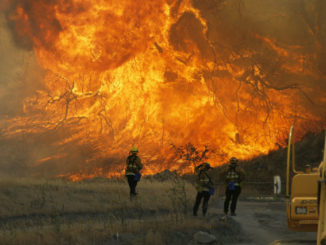
GUATEMALA CITY – The death toll has risen in Guatemala, where hundreds of rescuers are searching through ash Tuesday following the eruption at Mount Fuego.
Officials said at least 69 people are dead and that figure is expected to rise possibly into the hundreds. Only 17 have been identified so far, according to Guatemala’s National Institute of Forensic Sciences.
Another 46 people are missing, says the country’s disaster agency, known as Conred.

The volcano, which sits less than 30 miles from the capital, Guatemala City, erupted just before noon Sunday, sending towering clouds of ash miles into the air and hot flows of ash mixed with water and debris down its flanks, blocking roads and burning homes.
Love and prayers to Guatemala ♥️???? pic.twitter.com/zDdRpSNvNK
— Ayydé™ (@idayallday) June 4, 2018
A second powerful eruption followed at 6:45 p.m.
Praying for all in the path of and affected by the volcano in Guatemala. ???? At least 7 people have been killed and 296 injured from the volcano’s second eruption this year. We are sending love from Puerto Rico and here to help however we can! pic.twitter.com/pttXZr6VKv
— Erin Schrode (@ErinSchrode) June 4, 2018
Ash from the volcano fell on the capital area as well as the departments of Sacatepequez, Chimaltenango and Escuintla. Streets and houses were covered in the town of Antigua, a popular tourist destination.
By Monday, the intense activity had subsided, Conred said. The volcano, whose name means “fire,” had returned to its normal state of activity.
Some two million people were affected by the volcano’s ash, which billowed 15,000 feet into the air and dispersed over a nine-mile radius.

More than 3,000 people were evacuated, and at least 38 people were hospitalized, some of them with severe burns.
President Jimmy Morales has declared three days of national mourning.
The official death toll is 25 but volunteer firefighters say they have found another 10 bodies, according to local media.
A powerful earthquake has also hit the Guatemalan coast, though there are no reports of damage so far.
INFORMACIÓN PRELIMINAR. A las 9:06 horas se registro un sismo de magnitud 4.9, con epicentro a 142 kilómetros al Sur SurOeste de Retalhuleu.
Fuente: @insivumehgt pic.twitter.com/nXPDfPzv3Y— CONRED (@ConredGuatemala) June 4, 2018
Sergio Cabañas, head of the country’s National Disaster Management Agency (Conred), said the town of El Rodeo had been “buried”.
Other towns affected include Alotenango and San Miguel Los Lotes. Rescuers are still trying to reach a number of villages and the death toll is expected to rise.

Temporary shelters have been set up for about 3,000 residents who have been evacuated.
A total of about 1.7 million people have been affected in four regions. The country’s main airport has now reopened.
Earlier, Reuters reported that the aviation authorities closed Guatemala City’s international airport because of the danger posed to planes.

Officials have advised people to wear masks as protection against falling ash.
Mexico and Israel pledged support and offered assistance to Guatemala.
Toda nuestra solidaridad y apoyo al presidente @jimmymoralesgt y al pueblo guatemalteco por la pérdida de vidas humanas tras la erupción del Volcán de Fuego. A través de @PcSegob, hemos ofrecido asistencia para enfrentar esta contingencia.
— Enrique Peña Nieto (@EPN) June 4, 2018
Israel is sending an immediate emergency aid to #Guatemala, including medicine & food, following the lethal Fuego volcanic eruption.
Guatemala, Israel stands with you! ???? https://t.co/WC76q8mO7t
— Israel Foreign Min. (@IsraelMFA) June 4, 2018
One of Central America’s most active volcanos, the conical Volcan de Fuego reaches an altitude of 12,346 feet (3,763 meters) above sea level at its peak.
¿SABÍAS QUÉ? Las temperaturas medias de flujos piroclásticos en volcán de Fuego oscilan entre los 900 a 1200 grados Centígrados. Instituciones de primera respuesta del Sistema CONRED continúan trabajando en la búsqueda y localización de personas afectadas por la erupción. pic.twitter.com/To6x2G7abI
— CONRED (@ConredGuatemala) June 4, 2018
A major eruption devastated nearby farms in 1974, but no deaths were recorded.
Another eruption in February this year sent ash 1.7km (1.1 mile) into the sky.
This eruption is Guatemala’s deadliest such event since 1902, when an eruption of the Santa Maria volcano killed thousands of people.
Guatemala’s national institute of volcanology, Insivumeh, told people to keep away from the affected ravines as there is a possibility of “a reactivation”.



